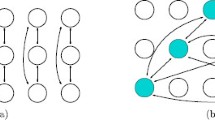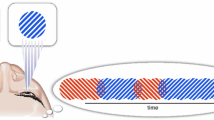Abstract
When similar visual stimuli are presented binocularly to both eyes, one perceives a fused single image. However, when the two stimuli are distinct, one does not perceive a single image; instead, one perceives binocular rivalry. That is, one perceives one of the stimulated patterns for a few seconds, then the other for few seconds, and so on – with random transitions between the two percepts. Most theoretical studies focus on rivalry, with few considering the coexistence of fusion and rivalry. Here we develop three distinct computational neuronal network models which capture binocular rivalry with realistic stochastic properties, fusion, and the hysteretic transition between. Each is a conductance-based point neuron model, which is multi-layer with two ocular dominance columns (L & R) and with an idealized “ring” architecture where the orientation preference of each neuron labels its location on a ring. In each model, the primary mechanism initiating binocular rivalry is cross-column inhibition, with firing rate adaptation governing the temporal properties of the transitions between percepts. Under stimulation by similar visual patterns, each of three models uses its own mechanism to overcome cross-column inhibition, and thus to prevent rivalry and allow the fusion of similar images: The first model uses cross-column feedforward inhibition from the opposite eye to “shut off” the cross-column feedback inhibition; the second model “turns on” a second layer of monocular neurons as a parallel pathway to the binocular neurons, rivaling out of phase with the first layer, and together these two pathways represent fusion; and the third model uses cross-column excitation to overcome the cross-column inhibition and enable fusion. Thus, each of the idealized ring models depends upon a different mechanism for fusion that might emerge as an underlying mechanism present in real visual cortex.













Similar content being viewed by others
References
Andrews, T.J., & Purves, D. (1997). Similarities in normal and binocularly rivalrous viewing. Proceedings of the National Academy of Sciences, 94(18), 9905–9908.
Blake, R. (1989). A neural theory of binocular rivalry. Psychological Review, 96(1), 145.
Blake, R., & Boothroyd, K. (1985). The precedence of binocular fusion over binocular rivalry. Perception & Psychophysics, 37(2), 114–124.
Blake, R., & Fox, R. (1974). Adaptation to invisible gratings and the site of binocular rivalry suppression. Nature, 249(5456), 488.
Blake, R., & Lema, S.A. (1978). Inhibitory effect of binocular rivalry suppression is independent of orientation. Vision Research, 18(5), 541–544.
Blake, R, & O’Shea, RP. (1988). “abnormal fusion” of stereopsis and binocular rivalry. Psychological Review, 95, 151–154.
Bosking, W.H., Zhang, Y., Schofield, B., & Fitzpatrick, D. (1997). Orientation selectivity and the arrangement of horizontal connections in tree shrew striate cortex. Journal of Neuroscience, 17(6), 2112–2127.
Brascamp, J.W., & Blake, R. (2012). Inattention abolishes binocular rivalry: perceptual evidence. Psychological Science, 23(10), 1159–1167.
Brown, R.J., & Norcia, A.M. (1997). A method for investigating binocular rivalry in real-time with the steady-state vep. Vision research, 37(17), 2401–2408.
Buckthought, A., Kim, J., & Wilson, H.R. (2008). Hysteresis effects in stereopsis and binocular rivalry. Vision Research, 48(6), 819–830.
Cai, D., Rangan, A.V., & McLaughlin, D.W. (2005). Architectural and synaptic mechanisms underlying coherent spontaneous activity in v1. Proceedings of the National Academy of Sciences, 102(16), 5868–5873.
Cavanagh, P., & Holcombe, A.O. (2006). Successive rivalry does not occur without attention. Journal of Vision, 6(6), 818–818.
Chariker, L., Shapley, R., & Young, L.S. (2016). Orientation selectivity from very sparse lgn inputs in a comprehensive model of macaque v1 cortex. Journal of Neuroscience, 36(49), 12368–12384.
Cohen, B.P., Chow, C.C., & Vattikuti, S. (2019). Dynamical modeling of multi-scale variability in neuronal competition. Communications Biology, 2(1), 1–11.
Della Porta, G. (1593). De refractione optices parte: libri novem... Ex officina Horatii Salviani, apud Jo. Jacobum Carlinum, & Antonium Pacem.
Dieter, K.C., Brascamp, J., Tadin, D., & Blake, R. (2016). Does visual attention drive the dynamics of bistable perception? Attention, Perception, & Psychophysics, 78(7), 1861–1873.
Dutour, E.F. (1760). Discussion d’une question d’optique [discussion on a question of optics]. Mémoires de Mathématique et de physique présentés par Divers Savants, 3, 514–530.
Gail, A., Brinksmeyer, H.J., & Eckhorn, R. (2004). Perception-related modulations of local field potential power and coherence in primary visual cortex of awake monkey during binocular rivalry. Cerebral Cortex, 14(3), 300–313.
Homayoun, H., & Moghaddam, B. (2007). Nmda receptor hypofunction produces opposite effects on prefrontal cortex interneurons and pyramidal neurons. Journal of Neuroscience, 27(43), 11496–11500.
Huntley, G.W., Vickers, J., Janssen, W., Brose, N., Heinemann, S., & Morrison, J. (1994). Distribution and synaptic localization of immunocytochemically identified nmda receptor subunit proteins in sensory-motor and visual cortices of monkey and human. Journal of Neuroscience, 14(6), 3603–3619.
Jones, R., & Bühl, E. (1993). Basket-like interneurones in layer ii of the entorhinal cortex exhibit a powerful nmda-mediated synaptic excitation. Neuroscience Letters, 149(1), 35–39.
Kaufman, L., & Arditi, A. (1976). The fusion illusion. Vision Research, 16(5), 535–543.
Laing, C.R., & Chow, C.C. (2002). A spiking neuron model for binocular rivalry. Journal of Computational Neuroscience, 12(1), 39–53.
Legge, G.E., & Rubin, G.S. (1981). Binocular interactions in suprathreshold contrast perception. Perception & Psychophysics, 30(1), 49–61.
Leopold, D.A., & Logothetis, N.K. (1996). Activity changes in early visual cortex reflect monkeys’ percepts during binocular rivalry. Nature, 379(6565), 549.
Levelt, W.J. (1965). On binocular rivalry. PhD thesis, Van Gorcum Assen.
Li, H.H., Rankin, J., Rinzel, J., Carrasco, M., & Heeger, D.J. (2017). Attention model of binocular rivalry. Proceedings of the National Academy of Sciences, 114(30), E6192–E6201.
Ling, S., & Blake, R. (2012). Normalization regulates competition for visual awareness. Neuron, 75(3), 531–540.
Liu, L., Tyler, C.W., & Schor, C.M. (1992). Failure of rivalry at low contrast: evidence of a suprathreshold binocular summation process. Vision Research, 32(8), 1471–1479.
Maccaferri, G., & Dingledine, R. (2002). Control of feedforward dendritic inhibition by nmda receptor-dependent spike timing in hippocampal interneurons. Journal of Neuroscience, 22(13), 5462–5472.
MATLAB. (2018). version 9.4.0 (R2018a). Natick: The MathWorks Inc.,.
Moreno-Bote, R., Rinzel, J., & Rubin, N. (2007). Noise-induced alternations in an attractor network model of perceptual bistability. Journal of Neurophysiology, 98(3), 1125–1139.
Nelson, J.I. (1975). Globality and stereoscopic fusion in binocular vision. Journal of Theoretical Biology, 49 (1), 1–88.
O’Shea, R.P. (1987). Chronometric analysis supports fusion rather than suppression theory of binocular vision. Vision Research, 27(5), 781–791.
O’Shea, R.P., & Crassini, B. (1981). The sensitivity of binocular rivalry suppression to changes in orientation assessed by reaction-time and forced-choice techniques. Perception, 10(3), 283–293.
Polonsky, A., Blake, R., Braun, J., & Heeger, D.J. (2000). Neuronal activity in human primary visual cortex correlates with perception during binocular rivalry. Nature Neuroscience, 3(11), 1153.
Said, C.P., & Heeger, D.J. (2013). A model of binocular rivalry and cross-orientation suppression. PLoS Computational Biology, 9(3), e1002991.
Shpiro, A., Curtu, R., Rinzel, J., & Rubin, N. (2007). Dynamical characteristics common to neuronal competition models. Journal of Neurophysiology, 97(1), 462–473.
Stimberg, M., Goodman, D.F., Benichoux, V., & Brette, R. (2013). Brian 2-the second coming: spiking neural network simulation in python with code generation. BMC Neuroscience, 14(1), P38.
Tong, F., & Engel, S.A. (2001). Interocular rivalry revealed in the human cortical blind-spot representation. Nature, 411(6834), 195.
Tong, F., Meng, M., & Blake, R. (2006). Neural bases of binocular rivalry. Trends in Cognitive Sciences, 10(11), 502–511.
Wade, N.J. (1998). A natural history of vision. MIT press.
Wang, H.X., & Gao, W.J. (2009). Cell type-specific development of nmda receptors in the interneurons of rat prefrontal cortex. Neuropsychopharmacology, 34(8), 2028.
Wilson, H.R. (2003). Computational evidence for a rivalry hierarchy in vision. Proceedings of the National Academy of Sciences, 100(24), 14499–14503.
Wilson, H.R. (2017). Binocular contrast, stereopsis, and rivalry: toward a dynamical synthesis. Vision research, 140, 89–95.
Wolfe, J.M. (1986). Stereopsis and binocular rivalry. Psychological Review, 93(3), 269.
Wolfe, JM. (1988). Parallel ideas about stereopsis and binocular rivalry: a reply to blake and o’shea (1988). Psychological review.
Wong-Riley, M., Anderson, B., Liebl, W., & Huang, Z. (1998). Neurochemical organization of the macaque striate cortex: correlation of cytochrome oxidase with na+ k+ atpase, nadph-diaphorase, nitric oxide synthase, and n-methyl-d-aspartate receptor subunit 1. Neuroscience, 83(4), 1025–1045.
Xu, H., Han, C., Chen, M., Li, P., Zhu, S., Fang, Y., Hu, J., Ma, H., & Lu, H.D. (2016). Rivalry-like neural activity in primary visual cortex in anesthetized monkeys. Journal of Neuroscience, 36 (11), 3231–3242.
Zhang, P., Jamison, K., Engel, S., He, B., & He, S. (2011). Binocular rivalry requires visual attention. Neuron, 71(2), 362–369.
Zhou, D., Rangan, A.V., McLaughlin, D.W., & Cai, D. (2013). Spatiotemporal dynamics of neuronal population response in the primary visual cortex. Proceedings of the National Academy of Sciences, 110(23), 9517–9522.
Acknowledgements
We thank David Heeger and John Rinzel for very helpful and informative discussions.
Author information
Authors and Affiliations
Corresponding author
Ethics declarations
Conflict of interests
The authors have no conflict of interests.
Additional information
Action Editor: A. Borst
Publisher’s note
Springer Nature remains neutral with regard to jurisdictional claims in published maps and institutional affiliations.
Rights and permissions
About this article
Cite this article
Wang, Z., Dai, W. & McLaughlin, D.W. Ring models of binocular rivalry and fusion. J Comput Neurosci 48, 193–211 (2020). https://doi.org/10.1007/s10827-020-00744-7
Received:
Revised:
Accepted:
Published:
Issue Date:
DOI: https://doi.org/10.1007/s10827-020-00744-7




